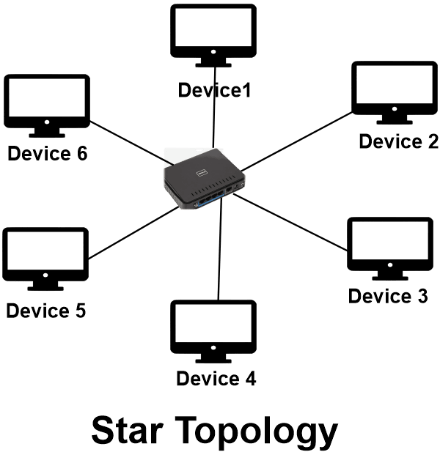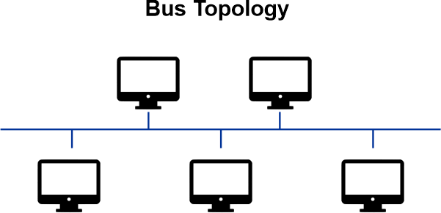Difference between Star Topology and Bus Topology
Star Topology
Star topology is a network configuration in which each device is connected to a central node (or hub) that acts as a common connection point. This central hub is responsible for transmitting and receiving data to and from all connected devices. The star topology is a popular choice for Ethernet networks because it reduces the risk of network failure and improves performance by providing a dedicated connection between each device and the central hub.

Characteristics of Star Topology
The main characteristics of star topology are:
- Centralized structure: Each device is connected to a central node, usually a hub or switch, which acts as a single point of communication.
- Point-to-point connections: Each device has a dedicated, point-to-point connection to the central hub.
- Improved reliability: If one device fails, it doesn't affect the rest of the network, as only the affected device is isolated.
- Scalable: The network can be easily expanded by adding more devices to the central hub.
- Easy maintenance: Diagnosing and repairing network issues is easier as each device has a separate connection to the central hub.
- Good performance: The network's performance is not affected by heavy traffic in one segment, as the central hub manages the flow of data.
- Increased cost: The cost of a star topology network is higher due to the need for a central hub and additional cabling.
Advantages of Star Topology
- Easy to install and manage
- Improved reliability and reduced network failure
- Easy to add or remove devices
- Scalable
- Centralized management and control
- Improved performance due to dedicated point-to-point connections
- Isolation of network problems to a single device
- Reduced cabling requirements compared to other topologies.
Disadvantages of Star Topology
- Single point of failure (central node)
- Higher cost due to need for central node and additional cabling
- Performance degradation when central node becomes congested
- Limited by the bandwidth of the central node
- Dependence on the central node for network communication.
Bus Topology
Bus topology is a type of network configuration in which all devices are connected to a single cable or bus that acts as the backbone of the network. Data is transmitted along this bus, and all devices can receive and access it. In bus topology, when one device sends data, it is broadcasted to all other devices on the network.

Characteristics of Bus topology
- Linear structure: All devices are connected to a single cable, or bus, that acts as the backbone of the network.
- Broadcasting: When one device sends data, it is broadcasted to all other devices on the network.
- Cost-effective: Bus topology is a cost-effective option for small networks.
- Simple installation: It is simple to install and connect new devices to a bus topology network.
- Limited network size: Bus topology is limited in terms of network size and scalability.
- Single point of failure: The bus cable is a single point of failure, and if it fails, the entire network goes down.
- Collisions: Data collisions can occur if two devices try to transmit data at the same time.
- Performance degradation: As the number of devices on the network increases, the performance of the network can degrade.
Advantages of star topology
- Simple to install and configure
- Cost-effective for small networks
- Easy to connect new devices
- Low cost of cable and other network components.
Disadvantages of star topology
- Limited network size and scalability.
- Performance degradation as the number of devices on the network increases.
- Single point of failure (the bus cable) can bring down the entire network.
- Difficult to troubleshoot and diagnose network problems.
- Data collisions can occur if two devices try to transmit at the same time.
Difference between Star and Bus topology
| Feature | Star Topology | Bus Topology |
| Structure | Centralized with each device connected to a central hub. | Linear with all devices connected to a single cable. |
| Point to point connections | Each device has a dedicated, point to point connection to the central hub. | All devices are connected to a single bus cable. |
| Reliability | Improved, as a failure in one device only affects that device. | Reduced, as the bus cable is a single point of failure. |
| Scalability | Easily scalable by adding more devices to the central hub. | Limited by the size of the bus cable and the number of devices that can be connected. |
| Performance | Generally better, as the central hub manages the flow of data. | Can degrade as the number of devices on the network increase. |
| Maintenance | Easier as each device has a separate connection to the central hub. | More difficult as all devices share the same bus cable. |
| Cost | Higher due to the need for a central hub and additional cabling. | Lower for small networks, due to the simple installation and low cost of components. |